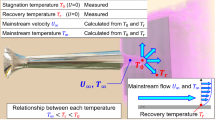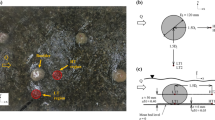Abstract
Most wet-type multi-path ultrasonic flowmeters have their measurement accuracy rate deteriorate as the flow rate is decreased. Curve-fitting on the characteristics of ultrasonic flowmeters is essential to improve their measurement accuracy rate. This hinders their use as transfer standards in inter-laboratory comparisons for water flow metrology. A breakthrough to enhance the measurement accuracy rate of ultrasonic flowmeters is needed. This study suggests that the concept of near-wall flow velocity should enhance the characteristics of ultrasonic flowmeters. As a result, repeatability can be improved as low as ±0.02 %, which should be suitable to be used as transfer standards. Two main points of using the near-wall flow velocity for ultrasonic flowmeters are emphasized. One is a formula to describe the near-wall flow velocity as a function of both Reynolds number and surface roughness. The other is the results of comparison calibrations between two national metrology institutes, which can support measurement equivalence. In particular, the number of equivalence is less than one (∣En∣ ≤ 1), and the inconclusiveness parameter is less than two (ucomp/ubase ≤ 2) if the near-wall flow velocity is applied for ultrasonic flowmeters. This implies that the ultrasonic flowmeters could be used as transfer standards for the forthcoming inter-laboratory comparisons.
Similar content being viewed by others
Abbreviations
- D :
-
Pipe diameter (m)
- E n :
-
Number of equivalence
- K :
-
K-factor (pulse/L)
- K 0 :
-
Reference K-factor (pulse/L)
- K FPCF :
-
Flow profile correction factor
- Re :
-
Reynolds number
- U (e KRISS):
-
Measurement uncertainty of KRISS (%)
- U (e PTB):
-
Measurement uncertainty of PTB (%)
- V 1% :
-
Near-wall flow velocity (m/s)
- V max :
-
Maximum flow velocity (m/s)
- \(\bar V\) :
-
Averaged flow velocity in a pipe flow (m/s)
- \(\overline {{V_l}}\) :
-
Line-averaged flow velocity in a pipe flow (m/s)
- c i :
-
Curve-fitting coefficient (i = 1 ∼ 7)
- e :
-
Meter error (%)
- e KRISS :
-
Meter error calibrated by KRISS (%)
- e PTB :
-
Meter error calibrated by PTB (%)
- f :
-
Darcy friction factor
- k :
-
Turbulent kinetic energy (m2/s2)
- n :
-
Reciprocal to the exponent of a flow profile
- p :
-
Fluid pressure (Pa)
- r :
-
Radial direction (m)
- v :
-
Flow velocity (m/s)
- q :
-
Volume flow rate (m3/h)
- q 0 :
-
Reference volume flow rate (m3/h)
- q max :
-
Maximum volume flow rate (m3/h)
- t :
-
Time (s)
- u base :
-
Uncertainty factor by measurement standard (%)
- u comp :
-
Uncertainty factor by flowmeter under test (%)
- x :
-
Streamwise direction along a pipe (m)
- y :
-
Horizontal direction in the pipe cross-section (m)
- z :
-
Vertical direction in the pipe cross-section (m)
- ε :
-
Turbulent energy dissipation (m2/s3)
- ϵ :
-
Roughness of pipe surface (mm)
- θ :
-
Angular direction (rad)
- μ :
-
Fluid viscosity (mPa·s)
- ρ :
-
Fluid density (kg/m3)
- ∇:
-
Del operator \(\left( {\nabla = \left( {{\partial \mathord{\left/ {\vphantom {\partial {\partial x}}} \right.} {\partial x}}} \right)\,{\mathbb{i}}\,{\rm{ + }}\,\left( {{\partial \mathord{\left/{\vphantom {\partial {\partial y}}} \right.} {\partial y}}} \right)\,{\mathbb{j}}\,{\rm{ + }}\,\left( {{\partial \mathord{\left/ {\vphantom {\partial {\partial z}}} \right.} {\partial z}}} \right)\,{\mathbb{k}}} \right)\)
References
E. Frahm, N. Furuichi, R. Arias, C.-T. Yang, S. Chun, T. Meng, I. Shinder, O. Büker, C. Mills, B. Akselli and F. M. Smits, Final report “Key comparison CCM.FF-K1.2015 - water flow: 30 m3/h … 200 m3/h”, Metrologia, 59 (2022) 07013.
J. Wright, B. Toman, B. Mickan, G. Wübbeler, O. Bodnar and C. Elster, Transfer standard uncertainty can cause inconclusive inter-laboratory comparisons, Metrologia, 53 (2016) 1243–1258.
S. Chun, J. Park and B.-R. Yoon, A Method of Measuring the Near-Wall Velocity of Pipelines and Recording Medium on Which the Same Algorithm is Recorded, KIPO (Ed.), Korea (2023) 1–21.
S. Chun and N. Furuichi, Final report of the APMP water flow supplementary comparison (APMP.M.FF-S1), Metrologia, 59 (2022) 07004.
ISO 12242:2012, Measurement of Fluid Flow in Closed Conduits — Ultrasonic Transit-Time Meters for Liquid, International Organization for Standardization, Geneva, Swiss (2012).
ISO 17089-1:2019, Measurement of Fluid Flow in Closed Conduits — Ultrasonic Meters for Gas, Part 1: Meters for Custody Transfer and Allocation Measurement, International Organization for Standardization, Geneva, Swiss (2019).
ISO 17089-2:2012, Measurement of Fluid Flow in Closed Conduits — Ultrasonic Meters for Gas, Part 2: Meters for Industrial Applications, International Organization for Standardization, Geneva, Swiss (2012).
F. B. Hildebrand, Introduction to Numerical Analysis, Second Edition, Dover, Mineola, USA (1987).
ISO 5167-1:2003, Measurement of Fluid Flow by Means of Pressure Differential Devices Inserted in Circular Cross-Section Conduits Running Full, Part 1: General Principles and Requirements, International Organization for Standardization, Geneva, Swiss (2003).
ISO 4185:1980, Measurement of Liquid Flow in Closed Conduits - Weighing Method, International Organization for Standardization, Geneva, Swiss (1980).
L. Cordova and T. Lederer, A practical method to assess the performance of gravimetric flow test rigs by using the timing error, Flow Measurement and Instrumentation, 44 (2015) 61–70.
S. Chun, B.-R. Yoon and H.-M. Choi, Uncertainty estimation of a liquid flow standard system with small flow rates, Measurement, 51 (2014) 367–376.
S. Chun, B.-R. Yoon, H.-M. Choi and Y. B. Lee, Water flow meter calibration with a master meter method, International Journal of Precision Engineering and Manufacturing, 18 (2017) 1075–1083.
S. Chun, A mathematical model of control volume uncertainty for comparison calibration in water flow metrology, Measurement: Sensors, 18 (2021) 100106.
P. K. Kundu, I. M. Cohen and D. R. Dowling, Fluid Mechanics, Elsevier, Oxford, UK (2016).
J. H. Spurk and N. Aksel, Fluid Mechanics, Third Edition, Springer Nature, Cham, Switzerland (2020).
J. Mathieu and J. Scott, An Introduction to Turbulent Flow, Cambridge University Press, Cambridge, UK (2000).
K.-J. Bathe, Finite Element Procedures, Second Edition, ADINA R&D, Boston, USA (2014).
S. Chun, B.-R. Yoon, W. Kang and H.-S. Kwon, Assessment of combined V/Z clamp-on ultrasonic flow metering, J. of Mech. Sci. and Tech., 28 (2014) 2169–2177.
B. Ioose, C. Lhuillier and H. Jeanneau, Numerical simulation of transit-time ultrasonic flowmeters: uncertainties due to flow profile and fluid turbulence, Ultrasonics, 40 (2002) 1009–1015.
ISO/IEC Guide 98-4:2012, Uncertainty of Measurement - Part 4: Role of Measurement Uncertainty in Conformity Assessment, International Organization for Standardization, Geneva, Swiss (2012).
Acknowledgments
Sejong Chun is grateful to Enrico Frahm at PTB, Germany for providing the measurement service of calibrating two ultrasonic flowmeters developed by HSCMT Co. Ltd. (150 mm, 250 mm). The calibration results by PTB were critical in validating the measurement accuracy rate of these flowmeters. Sejong Chun is also grateful to Jim Collins for grammatical and organizational proofreading.
This study was financially supported by Korea Research Institute of Standards and Science [grant numbers 22011057, 22011259, 23011289], and Ministry of Trade, Industry and Energy [grant number 20014363, 20025202], Republic of Korea.
Author information
Authors and Affiliations
Corresponding author
Additional information
Jungkyu Park is the Technical Director of KOLAS liquid flow calibration center in HSCMT. In addition, he is conducting research on energy convergence technology and measuring instrument in the Department of Environmental Engineering at Hoseo University.
Sejong Chun is a Principal Researcher at KRISS in Korea since 2005. He has been working as a service manager for water flow metrology since 2011. His research interests are measurement uncertainty, fluid flow measurement standards, ultrasonic flowmeters, and laser Doppler anemometers.
Byung-Ro Yoon is a Principal Research Technician at KRISS, Korea. He has been working in the field of liquid flow and viscosity metrology for more than 20 years. His expertise is test & calibration of various liquid flowmeters and viscometers. Some examples are Coriolis mass flowmeters and Cannon-Fenske capillary viscometers.
Joohyun Kim is a Senior Researcher at Fluid Flow R&DB Center in HSCMT since 2020. He has been working on mechanical design since 2020 and in the field of computational fluid dynamics for more than 6 years. His fields include ultrasonic sensor design, flowmeter measuring tube design, and prototype production using 3D printing.
Jae-Yong Lee has worked at a flow-meter manufacturing company for 10 years, mainly doing testing and calibration work. His area of expertise is testing and calibration of liquid flowmeters, mainly ultrasonic flowmeters and electromagnetic flowmeters.
Rights and permissions
About this article
Cite this article
Park, J., Chun, S., Yoon, BR. et al. Development of wet-type ten-path ultrasonic flowmeters to validate their performance at two national metrology institutes. J Mech Sci Technol (2024). https://doi.org/10.1007/s12206-024-2105-6
Received:
Revised:
Accepted:
Published:
DOI: https://doi.org/10.1007/s12206-024-2105-6




